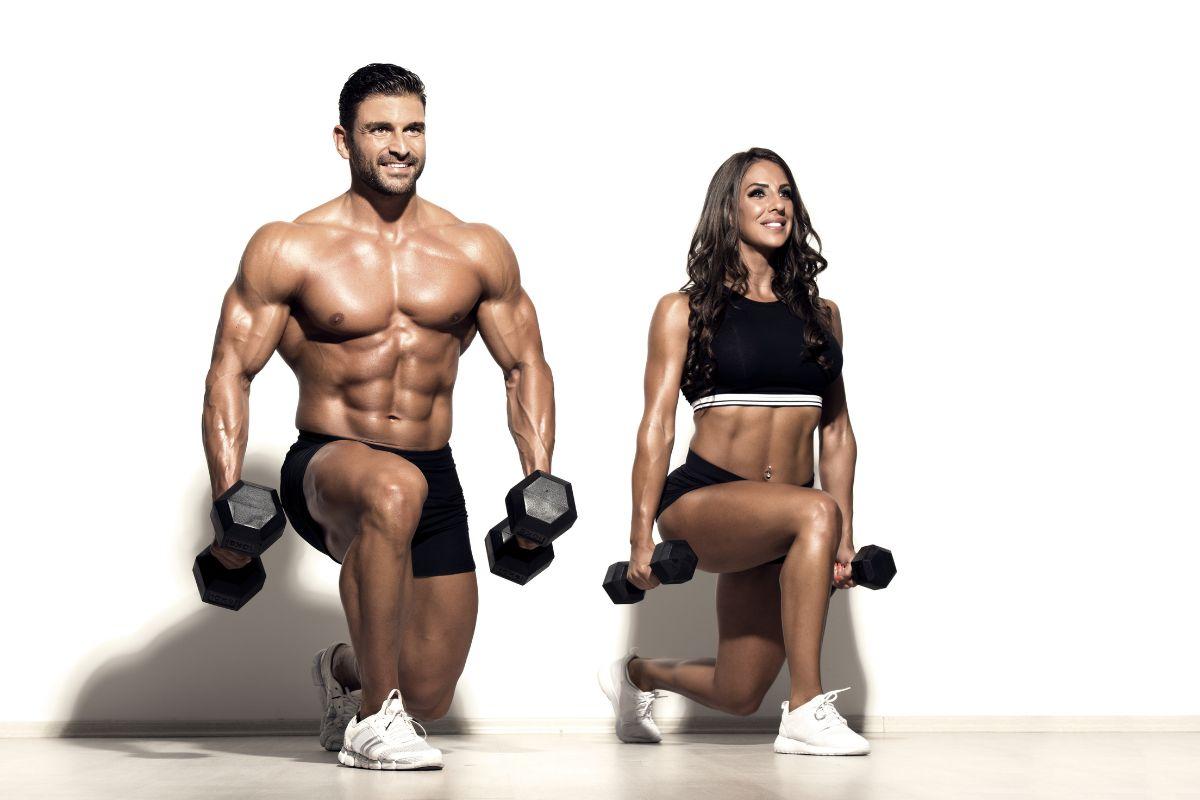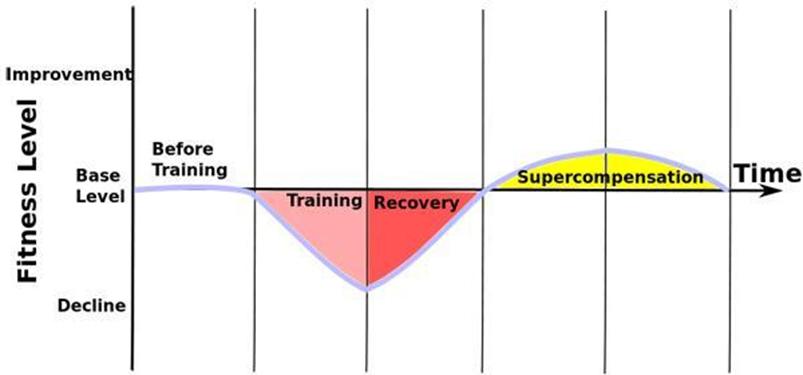What is supercompensation?
Saturday, february 4, 2023 You will read this text in min.
When performing strength training, you must have come across the term "supercompensation" at least once, but maybe you don't quite understand: What is it exactly? How long does it take? What benefits does it give you? Despite the fact that it's the basic phenomenon that trainees deal with, many of them don't fully understand the mechanisms governing this process, as well as our influence on its proper occurrence.

Keep in mind that supercompensation is an extremely desirable phenomenon, which, if skillfully induced, will contribute to your further training progress, so it's worth getting to know it and being able to apply it in practice.
What is supercompensation?
Supercompensation is the result of the body's adaptation to the applied training stimuli. It's a process necessary to develop musculature (under certain conditions, including: proper regeneration, rational strength training, increased supply of protein in the diet) and to improve athletic performance, and thus increase the functional capacity of the body and exercise capacity of organs.
By rebuilding energy reserves, the body tries to properly prepare for the effort and accumulates additional reserves. Muscle fibers that have been fully regenerated become harder and stronger. The key conditions that must be met for the supercompensation to run properly are: proper regeneration and nutrition of the muscles.
When does supercompensation occur?
In order to understand the supercompensation process, it's necessary to present the phases leading to its occurrence and loss step by step:
- Stage I – is the phase of introducing stress related to training or the load used during its performance, and then the body's reaction to the stress associated with it. Fatigue is the most common symptom, as well as a completely predictable reduction in performance levels due to the stress we cause ourselves. Catabolic processes begin to dominate the system. This stage usually takes 1-2 hours.
- Stage II – is the recovery phase, where, parallel to the end of the training, the rest phase begins, the purpose of which is to induce compensation, i.e. restore the body to its pre-training state of balance. As a result of the implementation of regeneration, the level of energy and performance have a chance to return to the state of homeostasis, i.e. internal balance (initial level). Examples of this could be: a rest day (recovery session), a shorter training session or an active rest (e.g. walk). This stage helps the body to rest after the previously experienced stressor, which was strength training. Anabolic processes are launched, striving to build, heal and eliminate the negative effects experienced as a result of training. About 3-5 minutes after the end of training, the ATP (adenosine triphosphate) stores are completely replenished. Phosphocreatine resynthesis takes place in about 8 minutes, while when you are dealing with very intense workouts, this process can take up to 15 minutes. Muscle glycogen levels reach baseline within 20-24 hours. The body repays its oxygen debt within 24-38 hours. There is an increase in resting energy expenditure, caused by strength or endurance training, which persists 15-48 hours after exercise. After resistance training in the so-called anabolic phase, the rate of protein synthesis increases, where after 24 hours this increase is about 109%. Protein synthesis returns to normal levels after 36 hours. The processes described above, which make up the compensation phase, last about 48 hours.
- Stage III – is the phase of supercompensation, which this article concerns. In other words, it's an adaptive rebound above the baseline, i.e. an over-rebuilding, during which the body accumulates energy "in reserve", expecting another hard effort. Changes taking place in the body bring the body to the level of internal balance (homeoastase), but this time exceeding the level before training (baseline). It's called "the rebound response" because of the body's reaction, which is the rebound from the lowest point of the greatest level of fatigue. This phase is both a physiological reaction of the body and a psychological one, which manifests itself in self-confidence and abilities, well-being, energy to act, optimism, ability to solve problems. It occurs in the range of 36-72 hours after training.
- Stage IV – is the phase of losing the supercompensation effect. Such a decrease is conditioned by the natural reaction of introducing a new training stress, which should take place at the peak of supercompensation. If no training stress is implemented during this time, there will also be a drop.

Graph showing the cycle: training - recovery - supercompensation.
How to use supercompensation?
With every workout, there's muscle fiber breakdown, depletion of key nutrients and, of course, muscle fatigue. This leads to a short-term decline in fitness levels. When microtrauma occurs in the muscles, the body will want to regenerate them by increasing protein synthesis.
This is to rebuild muscle tissue as quickly as possible. If recovery is adequate, supercompensation occurs, i.e. an increase in fitness level above the original base. This means that the muscles are rebuilt with a surplus – so that they can better meet emerging challenges in the future.
Supercompensation in practice
The supercompensation phase is the stage in which the trainee should apply the next training stimulus, similar in nature to the stimulus responsible for its induction. This is to increase the level of adaptation of the body in a specific area of activity to a higher state of equilibrium of the system. The cumulative impact of these stimuli will manifest itself in increasingly stronger and lasting changes and an increase in the body's adaptation to specific training activities.
On the other hand, failure to apply a training stimulus in the supercompensation phase will contribute to the disappearance of the physiological benefits caused by the last training, which will occur within 3-7 days.
Supercompensation and the frequency of training sessions
Considering the approach of competitive athletes who train more frequently than the laws of supercompensation should imply, it's clear that they are unable to achieve supercompensation after each training cycle. This is due to the fact that they make an effort even before the previous cycle of this process is completed. Nevertheless, more frequent training increases the speed of the athlete's fitness level, provided that the physical effort is varied in terms of training intensity and content.
In the case of 3 training units a week, the improvement of the player's overall fitness occurs more slowly than in, for example, during daily training. Therefore, an athlete who trains more often should vary the intensity of exercise. This can be done, for example by: planning alternating training units of high, medium and low intensity; manipulating energy expenditure and training content requirements; taking care of regeneration between training sessions and achieving a higher adaptive level.
Untapped potential for supercpompensation
The above issue may be caused by the lack of a training stimulus during the supercompensation period and its inadequate strength, causing stagnation, i.e. no improvement. In such a situation, the level of equilibrium of the system will remain at the same level, and adaptation will not have a chance for further progress.
In practice, such a situation occurs when the rest between training sessions is too long and the strength of the accumulated stimuli in a given unit is too small to trigger the supercompensation phase.
Too much high-intensity training
The body's adaptation to a new, higher level of balance (homeostasis) is gradual and requires time, repeated training stimuli of a specific intensity, as well as appropriate regeneration, during which the process of supercompensation is possible.
The signal to implement higher intensity training is the body's adaptation to the strength of the stimuli occurring before adapting to the new level of homeostasis. If you use high-intensity training too often or the stimulus strength is much higher than the intensity of the training stimulus, you'll not have time to compensate for the increasing fatigue.
In such a situation, the training stimulus will reach the non-optimal state of excessive fatigue of the body, when it won't be prepared to react with the process of supercompensation. The consequence of this will be defense against excessive exploitation, reduced homeostasis and lack of readiness to constructively accept the next stimuli.
This will cause the superstructure of the body's ability to work simply won't happen. Only maladaptation, i.e. lowering its level, will take place. Failure to adjust training stimuli will contribute to a decrease in the fitness of the trainee, increasing fatigue, overload and finally to overtraining.
Such a phenomenon should be prevented, e.g. by including training units of lower intensity in the training plan. This will allow time for compensation (rebalancing) to take place and then supercompensation as well.
Supercompensation and training mesocycles
In general, mesocycles are used to approach or achieve a specific goal in a given time. Let's assume that your goal is hypertrophy, i.e. the development of muscle mass. Although different sources give different ranges, it's assumed that a single training mesocycle should last 3-12 weeks.
For maximum supercompensation, you should aim for your baseline fitness level to drop temporarily. If the whole process goes well, you'll feel tired and weaker at the end of the microcycle. The key is that you keep moving forward. Your effort in the training room will be rewarded quickly.
How to achieve supercompensation?
When aiming for hypertrophy, the easiest way to promote supercompensation is to build training volume week by week. Increasing the volume can be achieved in several ways, and one of them is e.g. implementing additional sets to the compound or accessory exercises every week, e.g. in an alternating fashion, i.e. you should add them once to the compound exercise and the next time to the accessory exercise.
By following this strategy, you push your body's limits, constantly forcing it to work harder. At some point, you'll reach a stage where further progress won't be possible, and you'll feel that you have exploited your body to the maximum. This is the moment when you should perform a deload.
Otherwise, if you continue to try to push the limits, you can overtrain the nervous system, which is a very dangerous condition for the health of your body.
Supercompensation and muscle building
Effective muscle building requires a certain strategy. If you're determined to work hard and skilfully use supercompensation and the detraining stage, you'll certainly be satisfied with the results. Here is your action plan:
1. Build your training volume gradually over several weeks (about 4-8) until you feel you've given your best.
2. Reduce the volume by 50-60% for one week.
3. Take care of regeneration (including sleep) and proper nutrition of muscles.
Summary
The use of an appropriate training method, load progression scheme and gradual volume building require a lot of experience. These are just some of the elements that have a big impact on your progress. Many people who train in the gym lose weeks, and often even months, making wrong decisions related to training strategies or forgetting some important issues and assumptions.
It's important to raise the bar higher and higher, but you should never underestimate the first signs of overtraining. Therefore, what significantly affects supercompensation isn't only hard training, but also proper regeneration.
Well-thought-out training periodization (dividing physical activity into given cycles) and matching appropriate training methods and periods of detraining to them will make you achieve the body you've always dreamed of.